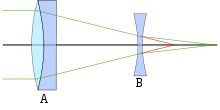Barlow lens
The Barlow lens, named after Peter Barlow, is a diverging lens which, used in series with other optics in an optical system, increases the effective focal length of an optical system as perceived by all components that are after it in the system. The practical result is that inserting a Barlow lens magnifies the image. A real barlow lens is not a single glass element, because that would generate chromatic aberration, and spherical aberration if the lens is not aspheric. More common configurations use three or more elements for achromatic correction or apochromatic correction and higher image quality.

Telescope use

In its astronomical use, a Barlow lens may be placed immediately before an eyepiece to effectively decrease the eyepiece's focal length by the amount of the Barlow's divergence.[1] Since the magnification provided by a telescope and eyepiece is equal to the telescope's focal length divided by the eyepiece's focal length, this has the effect of increasing the magnification of the image.
Astronomical Barlow lenses are rated for the amount of magnification they induce. Most commonly, Barlow lenses are 2x or 3x, but adjustable Barlows are also available. The power of an adjustable Barlow lens is changed by adding an extension tube between the Barlow and the eyepiece to increase the magnification.
The amount of magnification is one more than the distance between the Barlow lens and the eyepiece lens, when the distance is measured in units of the focal length of the Barlow lens. A standard Barlow lens is housed in a tube that is one Barlow focal-length long, so that a focusing lens inserted into the end of the tube will be separated from the Barlow lens at the other end by one Barlow focal-length, and hence produce a 2x magnification over and above what the eyepiece would have produced alone. If the length of a standard 2x Barlow lens' tube is doubled, then the lenses are separated by 2 Barlow focal lengths and it becomes a 3x Barlow. Similarly, if the tube length is tripled, then the lenses are separated by 3 Barlow focal lengths and it becomes a 4x Barlow, and so on.
A common misconception is that higher magnification equates to a higher-quality image. However, in practice, the quality of the image generally depends on the quality of the optics (lenses) and viewing conditions, not on magnification.
Photography use
Teleconverters are variations on Barlow lenses that have been adapted for photographic use.[2] A teleconverter increases the effective focal length of the photographic lens it is attached to, making it a telephoto lens. A true telephoto lens uses a configuration similar to a Barlow lens to obtain a shorter tube length for a given focal length.
Microscope use
In microscopy the Barlow lens is used to increase working distance and decrease magnification. The lenses are "objective lenses" that are mounted in front of the microscope's last objective element. Barlow lenses for microscopes can be found with magnifications ranging from 0.3× to 2×. Some standard lenses are 2×, which decreases the working distance by half and doubles the magnification, 0.75× (3/4×), which increases the working distance by 4/3× (1.33×) and decreases the magnification by 0.75×, and a 0.5× Barlow doubles the working distance and halves the magnification.
Gallery
 Barlow diagram
Barlow diagram
References
- Hartshorn, C. R. (1953). "The Barlow Lens". In Ingalls, Albert G. (ed.). Amateur Telescope Making, Book Three. Scientific American. pp. 277–286.
- Sidney F. Ray, Scientific photography and applied imaging, page 492